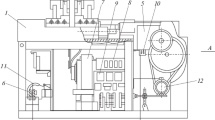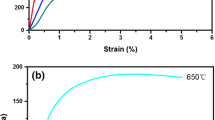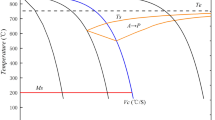Abstract
Welding is a complex process requiring combination of several process parameters. In this study, the effect of the thermal and electrical properties of carbon steel STKM13A during the welding assembly of rail car suspension system was investigated using numerical experiment. The welding parameters for the welding simulation process of the suspension system of the rail car are given as the following: voltage (24 V), current (220 A), speed (0.005 m/s), arc length (0.01 m), and efficiency (0.9). This serves as the input parameters into Simufact software version 7.2 for the simulation of the arc welding process at ambient temperature of 25 °C. Also, in order to study the effect of thermal and electrical conductivity on the welding process, the thermal and electrical modeling was carried out at room temperature to melting temperatures (25–1500 °C) using the average values of three critical parameters, namely specific heat (700 J/kg K), thermal conductivity (40 W/m K), coefficient of thermal expansion (1.5 × 10−5 K−1), electrical conductivity (2.5×10−7 − 1.14 × 10−6Ωm), and resistivity (4.0×10−6 − 8.77 × 105Ωm−1), as input parameters into the software. The statistical analysis of the results obtained brought about the development of a model that correlates electrical resistivity as function of the welding parameters for the optimization of welding process. In addition, the five input parameters are critical as they affect welding processes significantly, hence should be controlled to promote safe, reliable, and efficient welding processes.
Similar content being viewed by others
References
Ahmed ZI, Saadoon AM (2015) Optimization process parameters of submerged arc welding using Taguchi method. Int J Eng Adv Technol ISSN: 2249–8958 5(1):149–152
Mehta KP, Badheka VJ (2015) Influence of tool design and process parameters on dissimilar friction stir welding of copper to AA6061-T651 joints. Int J Adv Manuf Technol 80:2073–2082
Wahid MA, Khan NZ, Sharma N (2017) Effect of CNC milling machining parameters on depth of pocket. Global Sci-Tech 9:1–7
Hu Y, Chen Y, Li L, Hu H, Zhu Z (2016) Microstructure and properties of Al/Cu bimetal in liquid−solid compound casting process. Trans Nonferrous Metals Soc China 26:1553–1563
Armentani E, Esposiro R, Sepe R (2007) Effect of thermal properties and weld efficiency on residual stresses in welding. J Achiev Mater Manuf Eng 20(1–2):1–4
Neggi V, Chattopadhyaya (2013) Critical assessment of temperature distribution in submerged arc welding process. Adv Mater Sci Eng 2013:1–10
Ataev IF, Dedegkaeva LM, Manukyants AR, Ponezhev MK, Punis VS, Sozaev VA (2015) Thermal and electrical conductivity of a copper—aluminum micro (nano) composite material. Bull Russ Acad Sci Phys 79:1577–1579
Mishra RS, Ma ZY (2005) Friction stir welding and processing. Mater Sci Eng Res Rep 50:1–78
Nandan R, Debroy T, Bhadeshia HK (2008) Recent advances in friction-stir welding—process weldment structure and properties. Prog Mater Sci 53:980–1023
Long H, Gery D, Carlier A, Maropoulos PG (2009) Prediction of welding distortion in butt joint of thin plates. Mater Des 30:4126–4135
Liu C, Ge QL, Chen DJ, Gao F, Zou JS (2016) Residual stress variation in a thick welded joint after ultrasonic impact treatment. Sci Technol Weld Join 21:624–631
Sharma N, Khan ZA, Siddiquee AN, Shihab SK, Wahid MA (2018a) Effect of process parameters on microstructure and electrical conductivity during FSW of Al-6101 and pure copper. Mater Res Express 5:1–12
Kozak J, Kowalski G (2015) Problems of determination of welding angular distortions of T-fillet joints in ship hull structures. Pol Marit Res 22(2):79–85
Gibson BT, Lammlein DH, Prater TJ, Longhurst WR, Cox CD, Ballun MC, Dharmaraj KJ, Cook GE, Strauss AM (2014) Friction stir welding: process, automation, and control. J Manuf Process 16:56–73
Mullins J, Gunnars G (2009) Influence of hardening model on weld residual stress distribution. Inspecta Techno AB Stockholm, Sweden 16:1–38
Zhou J, Hayden M, Gao X (2012) An investigation of the strain rate and temperature effects on the plastic flow stress and ductile failure strain of aluminum alloys 5083-H116, 6082-T6 and a 5183 weld metal. Proc Inst Mech Eng C J Mech Eng Sci 227(5):883–895
Yan D, Liu X, Li J (2010) Effect of strain hardening and strain softening on welding distortion and residual stress of A7N01-T4 aluminum alloy by simulation analysis. J Cent S Univ Technol 17:666–673
Shiga C, Yasuda HY, Hiraoka K, Suzuki H (2010) Effect of MS temperature on residual stress in welded joints of high-strength steels. Weld World 54:1–9
Liu C, Chen DJ, Hill MR, Tran MN, Zou JS (2017) Effects of ultrasonic impact treatment on weld microstructure, hardness, and residual stress. Mater Sci Technol 33:1601–1609
Liu C, Zhu HY, Dong CL (2014) Internal residual stress measurement on inertia friction welding of nickel-based super alloy. Sci Technol Weld Join 19:408–415
Kartal ME, Kang Y-H, Korsunsky AM, Cocks ACF, Bouchard JP (2016) The influence of welding procedure and plate geometry on residual stresses in thick components. Int J Solids Struct 80:420–429
Sun TZ, Roy MJ, Strong D, Withers PJ, Prangnell PB (2017) Comparison of residual stress distributions in conventional and stationary shoulder high-strength aluminum alloy friction stir welds. J Mater Process Technol 242:92–100
Smith M, Levesque J-B, Bichler L, Sediako D, Gholipour J, Wanjara P (2017) Residual stress analysis in linear friction welded in-service Inconel 718 super alloy via neutron diffraction and contour method approaches. Mater Sci Eng 691:168–179
Chougule MN, Somase SC (2014) Experimental and analytical study of thermally induced residual stresses for stainless steel grade using GMAW process. 5th International & 26th All India Manufacturing Technology, Design and research conference (AIMTDR 2014) December 12th -14th, 2014, IIT Guwahati, Assam, pp 674–679
Huang H, Ma N, Murakawa H (2014) Fast prediction of welding distortion using ISM and i-ISM with validation by experiment: 24th International Ocean and Polar Engineering Conference, June 15–20, Busan, Korea; 2014
Song S, Dong P (2017) Residual stresses at weld repairs and effects of repair geometry. Sci Technol Weld Join 22:265–277
Sharma N, Siddiquee AN, Khan ZA, Mohsin T (2018b) Material stirring during FSW of Al-Cu:effect of pin profile. Mater J Manuf Process 33:786–794
Khan NZ, Shihab SK, Sharma N, Wahid AN, Siddiquee A, Khan ZA (2015) Investigation on the effect of WEDM process parameters on surface roughness. Global Sci Tech 7:1–9
Wahid MA, Siddiquee AN, Khan ZA, Asjad M (2016) Friction stir welds of al alloy-Cu: an investigation on effect of plunge depth. Arch Mech Eng 63:619–634
Sharma N, Khan ZA, Siddiquee AN (2017) Friction stir welding of aluminum to copper—an overview. Trans Nonferrous Metals Soc China 27:2113–2136
Ma C, Bhole SD, Chen DL, Lee A, Biro E, Boudreau G (2006) Expulsion monitoring in spot welded advanced high strength automotive steels. Sci Technol Weld Join 11:480–487
Wei PS, Wu TH (2012) Electrical contact resistance effect on resistance spot welding. Int J Heat Mass Transf 55:3316–3324
Pozo LP, Fernando OZ, Orlando DA (2015) Optimization of welding parameters using a genetic algorithm: a robotic arm–assisted implementation for recovery of pelton turbine blades. Adv Mech Eng 7(11):1–17
Parida B, Pal S (2015) Fuzzy assisted grey Taguchi approach for optimisation of multiple weld quality properties in friction stir welding process. Sci Technol Weld Join 20:35–41
Xu WH, Lin SB, Fan CL, Yang CL (2015) Prediction and optimization of weld bead geometry in oscillating arc narrow gap all-position GMA welding. Int J Adv Manuf Technol 79:183–196
Moradpour MA, Hashemi SH, Khalili K (2015) Multi-objective optimization of welding parameters in submerged arc welding of API X 65 steel plate. J Iron Steel Res Int 22:870–878
Rao RV, Rai DP (2017) Optimization of welding processes using quasi-oppositional-based Jaya algorithm. J Exp Theor Artif Intell 29(5):1099–1117. https://doi.org/10.1080/0952813X.2017.1309692
Karimi MR, Sedighi M, Afshari D (2015) Thermal contact conductance effect in modeling of resistance spot welding process of aluminum alloy 6061-T6. Int J Adv Manuf Technol 77:885–895
Kanigalpula PKC, Pratihar DK, Jha MN, Derose J, Bapat AV, Pal AR (2015) Experimental investigations, input/output modeling and optimization for electron beam welding of Cu-Cr-Zr alloy plates. Int J Adv Manuf Technol 85:711–726
Kaman MO, Celik N, Gokce I (2012) Thermal and residual stress anlayses of a welded stainless steel plate. 9th International Conference on Heat Transfer, Fluid Mechanics and Thermodynamics, 16–18 July 2012, Malta. pp. 871–876
Bhatti AA, Barsoum Z, Murakawa H, Barsoum I (2015) Influence of thermo-mechanical material properties of different steel grades on welding residual stresses and angular distortion. Mater Des 65:878–889
Perić M, Tonković Z, Garašić I, Vuherer T (2016) An engineering approach for a T-joint fillet welding simulation using simplified material properties. Ocean Eng 128:13–21
Petrescu V, Paraschiv G, Dobrotă D (2016) The optimization of welding regime parameters at shielded metal arc welding (SMAW) by mathematical modeling. Metalurgija 55(2):217–220
Liu C, Wang C, Cheng X, Yan Y, Yang J, Guo Y (2018) Experimental investigation on the residual stresses in a thick joint with a partial repair weld using multiple-cut contour method. Materials 11(633):1–12
Author information
Authors and Affiliations
Corresponding author
Rights and permissions
About this article
Cite this article
Daniyan, I.A., Mpofu, K. & Adeodu, A.O. Investigating the effect of carbon steel STKM 13a thermal and electrical properties during welding assembly of the lower brackets of a rail car. Int J Adv Manuf Technol 102, 43–53 (2019). https://doi.org/10.1007/s00170-018-3158-4
Received:
Accepted:
Published:
Issue Date:
DOI: https://doi.org/10.1007/s00170-018-3158-4




